Different parts of a fire department connection play a role in getting water to fire sprinkler or standpipe systems
Fire department connections (FDCs) ensure that certain fire sprinkler and standpipe systems can quickly get the water they need in an emergency. While some systems only need the FDC as a last resort, others require an external supply of water. Manual dry standpipe systems, for example, rely entirely on water pumped through an FDC for the water firefighters need.
In this article, we look at the role of the fire department connection in fire protection and explain how different parts of an FDC — from swivels to signs — make it possible.
If you already know everything you need to know and require equipment, browse our selection of fire department connections and accessories.
What are the parts of a fire department connection?
Most discussions of fire department connections focus on the inlet body, which contains all of the parts needed to connect a fire hose to the pipes supplying a fire sprinkler or standpipe system. However, a complete and NFPA-compliant FDC features three main sections, two of which are placed out of view:
- The piping to the sprinkler system riser or main
- A check valve, which prevents water from flowing in the wrong direction
- The inlet body
The inlet body of a fire department connection further consists of these parts:
- Swivels, which connect fire hose to the FDC’s inlets
- The inlets, which facilitate water’s entry into the FDC body
- An outlet connecting the body to system piping
- The body, which connects these components
Fire department connection components vary slightly across models. Some include clappers to direct the flow of water through the FDC and prevent water from exiting through open inlets. And fire department connections with Storz couplings may feature only the inlet and the outlet, providing a considerably more compact way to deliver a supply of water.
Most FDCs have a four-inch (4″) or six-inch (6″) outlet that connects to the building’s internal piping. That piping has either threaded ends — typically threaded with National Pipe Thread (NPT) — or grooved ends. Some have ends that are compatible with non-threaded Storz connections.
Open inlets have a tendency to gather dirt, dust, debris, and garbage, clogging system pipes. For that reason, NFPA-compliant fire department connections also feature breakable caps or combination plug and chain assemblies that protect the FDC’s inlets while the system is not in use.
What types of fire department connections are used today?
Three primary kinds of FDCs serve today’s fire protection systems: exposed, freestanding, and flush.
Exposed FDCs are found on the outside wall of a building. The body, inlets, and swivels remain (you guessed it) exposed for easy access by firefighters.
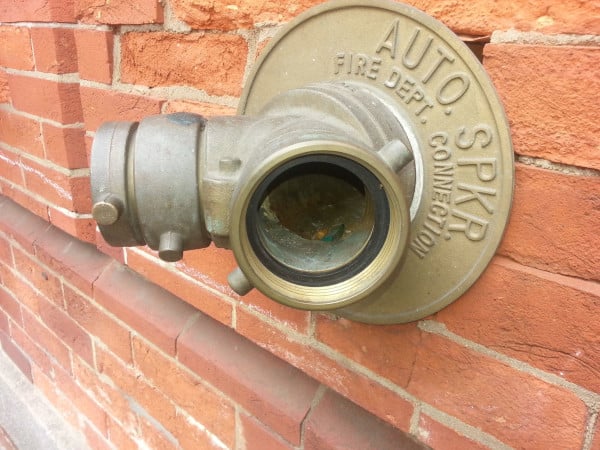
Freestanding connections act like exposed FDCs but stand apart from the building being supplied. Freestanding FDCs connect to the building’s system through a buried pipe, creating a convenient point of access for firefighters.
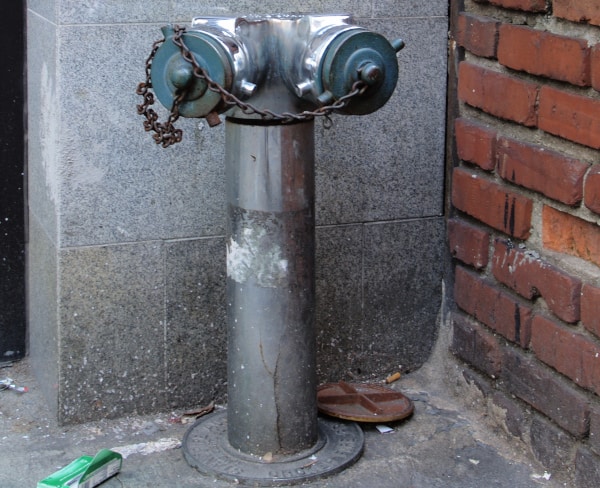
Flush connections install flush to the building’s wall, leaving only the inlet couplings or swivels exposed. The body and outlets sit behind the wall, fully concealed by an identification plate. Flush FDCs are considered more aesthetically appealing, especially when the building requires three or more inlets.
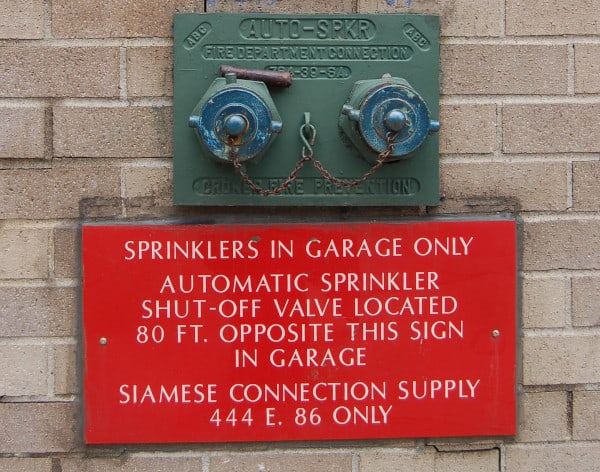
Proper placement of fire department connections promotes immediate access for firefighters
An inaccessible or hard-to-find FDC can paralyze a fire sprinkler or standpipe system if the water supply needs to be externally supplemented or supplied. As such, an FDC’s location should always maximize accessibility for firefighters.
While local fire codes and the preferences of fire authorities govern the exact placement of an FDC, it should be positioned on the street side of the building and be easily recognizable. Each fire department connection should be placed reasonably close to the nearest hydrant — 100 feet at most — but not so close that fire trucks or fire pumps near the hydrant lack clearance. Further, there must be enough space so the engine and its hoses do not obstruct access to the building once connected to the FDC, which would make it more difficult for firefighters to enter or exit the structure. A poorly placed hose can also limit the positions available to firefighters who fight fires with aerial ladders.
Required signage identifies the system served by a fire department connection
NFPA-compliant FDCs require minimum signage that denotes the system they serve such as “Automatic Sprinklers,” “Standpipes,” “Standpipe & Auto-Sprinkler,” or “Test Connection.” Most manufacturers provide rings to clearly label these connections.
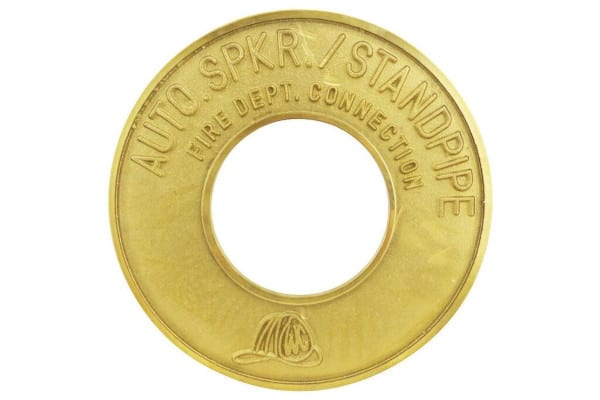
These signs help first responders quickly locate the connection they need and know exactly what they are connecting to. In addition, FDCs often feature signs that list the specific part or parts of the building that the fire sprinkler or standpipe system supplies.
Compatibility between the fire department’s hose connections and a building’s FDC couplings is paramount
The swivels on an FDC should always fit local fire hose couplings. Mismatched hose threads can delay firefighting efforts or render firefighters totally unable to supply water to a building’s fire protection system.
One of the most common FDCs, known as a Siamese or two-way connection, typically has two 2 1/2-inch female swivel connections. NFPA requires that all fire department connections use 2 1/2″ National Hose (NH) threaded female couplings unless the authority having jurisdiction designates another specific connection type.
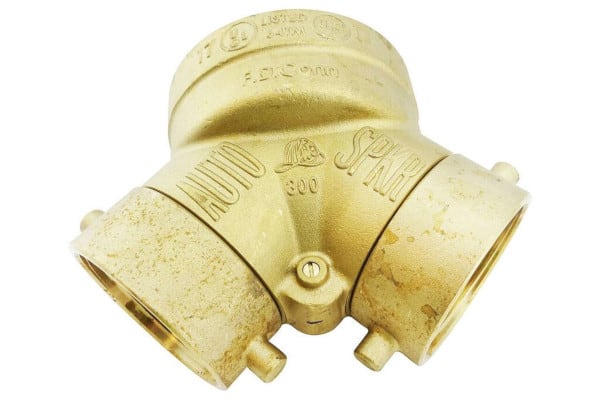
The use of these female swivels distinguishes many FDCs from other connections, including roof manifolds and fire pump test connections, which feature male-threaded inlets.
Clappers guide water through fire department connections
Pressurized water moving through fire department connections can close built-in “clappers.” These hinged parts prevent water from exiting through open inlets. On an FDC with two or more inlets, clappers allow firefighters to add or remove hoses as needed. If the flow of water to one hose stops (or a hose bursts) a clapper will close to prevent backflow. In the meantime, other hoses can continue to supply water through the other inlets.
Standard two-way FDCs may include either one or two clappers. The clapper on a single-clapper model swings freely between both inlets; water pressure from one inlet causes the clapper to block the unused inlet. When two hoses are used, the clapper takes a position between the two inlets, permitting the passage of water through both. These models use less material and are generally more affordable.
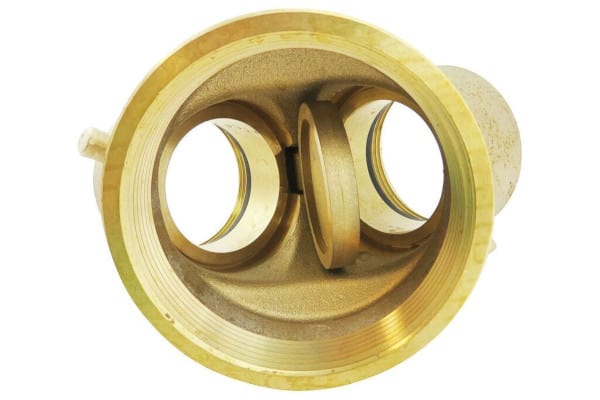
Double-clapper two-way fire department connections have one clapper for each inlet. While they are more expensive, double-clapper models offer added durability and an additional safeguard against bursting hose lines.
Water-based fire protection systems depend on fire department connections
Fire sprinkler systems rely on fire department connections for a supply of water when other sources are exhausted or unavailable. FDCs are also a key component for charging many standpipe systems. These systems are designed to provide water to servicing hoses in strategically placed locations inside a building or structure.
Standpipe systems are most common in large buildings, where areas of the facility are too far from an outside entrance, and multistory structures, where they eliminate the need for running long lengths of hose in stairwells and on the ground. Manual wet standpipe systems require external charging from outside sources of water and thus rely on the fire department connection for both their water and their water pressure. But in any case, including situations where firefighters merely need to supplement the water supply, the FDC located at the ground level is the liaison between built-in piping and an external supply of water.
How to choose a fire department connection for your building
Before replacing an FDC, you want to check several things, including the number of female inlets, the number of clappers, and the thread type. If you’re replacing an FDC, the easiest way to do this is by purchasing the same model. FDCs for NFPA-compliant systems should be selected and installed in accordance with local fire code along with NFPA 13: Standard for the Installation of Sprinkler Systems and NFPA 14: Standard for the Installation of Standpipe and Hose Systems.
QRFS offers durable fire department connection kits designed for use as flush or exposed FDCs. Our selection of brass and chrome-finished exposed FDCs includes two types: angled FDCs, which feature an outlet at a 90-degree vertical angle to the inlets, and straight FDCs, which place inlets and outlets at the same vertical angle. All of our angled exposed FDCs are perfect for use as freestanding fire department connections when coupled with a metal freestanding sleeve.
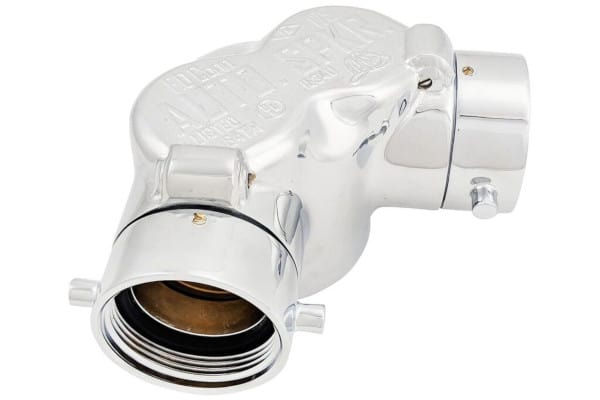
Our selection also includes flush double-clapper, two-way fire department connections in brass or chrome, available with NYC or NST-threaded swivels.
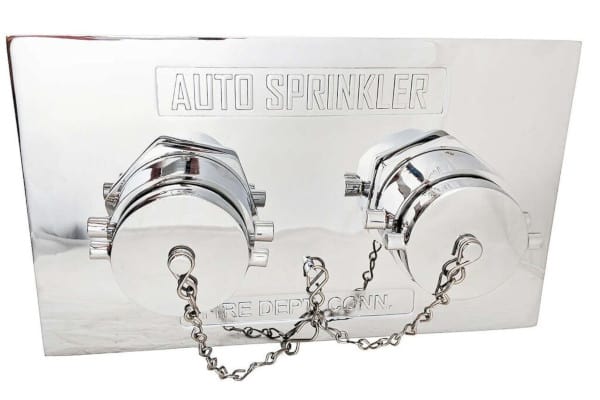
QRFS also makes it easy to add the FDC signs, ID plates, and breakable caps or durable plugs you need—simply look for the FDC you want or select accessories on the same page.
Browse all FDC Options and Accessories Here!
This blog was originally posted by Jason Hugo and Cameron Sharp at blog.qrfs.com on July 8, 2016, and updated on February 8, 2022. If this article helped you learn something valuable or select the right equipment, check us out at Facebook.com/QuickResponseFireSupply or on Twitter @QuickResponseFS.


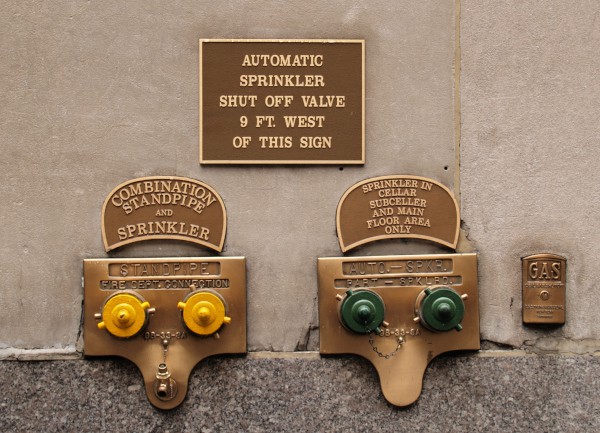
Installing a free standing Fire Department connection as required by the City agency. Is the best pipe steel /threaded and buried check value or exposed on vertical riser.
thx
Shawn
702-525-0668
Shawn —
Thanks for reaching out. For system application/code questions like this, we recommend submitting your question through QRFS Ask A Fire Pro. Click the link to submit your question with some information about your building or system, and a fire protection professional will provide a detailed answer based on standards and codes. Our pros include AHJs, contractors, engineers, and code experts with 150+ years of combined experience!
if a restaurant has outdoor seating and a temp wall is in the way to get to the Siamese connection, can I put sign stating it behind the wall or relocate the Siamese connection
Pocho pocho — Generally speaking, an FDC should not be blocked or hidden in any way that inhibits firefighters who need to easily spot and access the FDC (hook up hoses). So, while a sign might take care of ID, it won’t necessarily make the FDC easy to access with the wall — but it really depends on where the wall is in relation to the FDC and whether it causes problems. You could theoretically move an FDC, but this would require a system overhaul that is probably prohibitively expensive. Your best bet is to ask your local AHJ (often, the fire department) about the best course of action. Best of luck!
Is the FDC typically connected before or after the Alarm Check Valve?
YC — if by “after,” you mean location, the FDC typically connects to the system after (downstream, system side) of the alarm check valve. Though there are some additional considerations based on system types and multiple systems — and NFPA 13 doesn’t require check valves in all systems — the main applicable rule is here in NFPA 13 (same sections in 2019 and 2022 editions):
Hope that helps and thanks for reading!